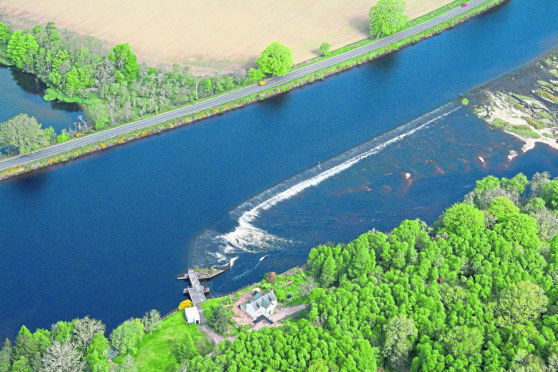Crucial work will take place over the next three months to safeguard Loch Dochfour reservoir near Inverness.
The loch forms a key part of the Caledonian Canal.
Scottish Canals has launched a new strategy setting out how it will manage and prioritise works on the infrastructure of the nation’s 250-year-old waterways between now and 2030, despite a £70 million repair backlog.
The organisation receives grant-in-aid of £11million each year from the Scottish Government to manage 140 miles of inland waterway and more than 4,100 individual assets.
In March, engineers completed a £2million project to extend the lifespan of the Thomas Telford-designed Ness Weir, which raises the water level to allow boats using the busy Caledonian Canal to move through Loch Dochfour into Loch Ness.
The work involved reinforcing the weir – constructed between 1825 and 1830 – with steel piling and this will preserve it for another century.
And Scottish Canals has now committed to undertaking a “high priority” £6,000 dam breach assessment at Loch Dochfour over the next three months.
The Scottish Canals website says there will also be a review of the flood assessment of the reservoir, as well as plans to remove trees at Torvean to reduce the risk of erosion.
It says planned studies are required to check that existing water retaining structures can withstand extreme floods.
A Scottish Canals spokesman said: “As with all our reservoirs, Loch Dochfour is managed through the statutory inspection process and we regularly receive and action the recommendations to ensure that they remain safe.”
The Caldedonian Canal is one of the north’s most popular visitor attractions with more than 1,400 boats using the canal each year, and it helps generate vital income for communities such as Fort Augustus.
But ageing infrastructure, the growing impact of climate change and increasing pressure on public finances has been blamed for a £70 million repair backlog.
The organisation estimates that Scotland’s canals require additional investment of between £6 million and £9 million each year – and have done for a number of years.
Catherine Topley, interim chief executive officer at Scottish Canals, said without additional investment they will continue to see a decline and asset failures, some of which may be “substantial.”
She added: “We simply do not have the resources to do all that we would like to do, and this means we will have to make some hard decisions.”
Richard Millar, director of infrastructure at Scottish Canals, said that earlier this year they were forced, as a result of safety concerns, to temporarily suspend boat transits through a number of bridges on the Forth and Clyde Canal.
